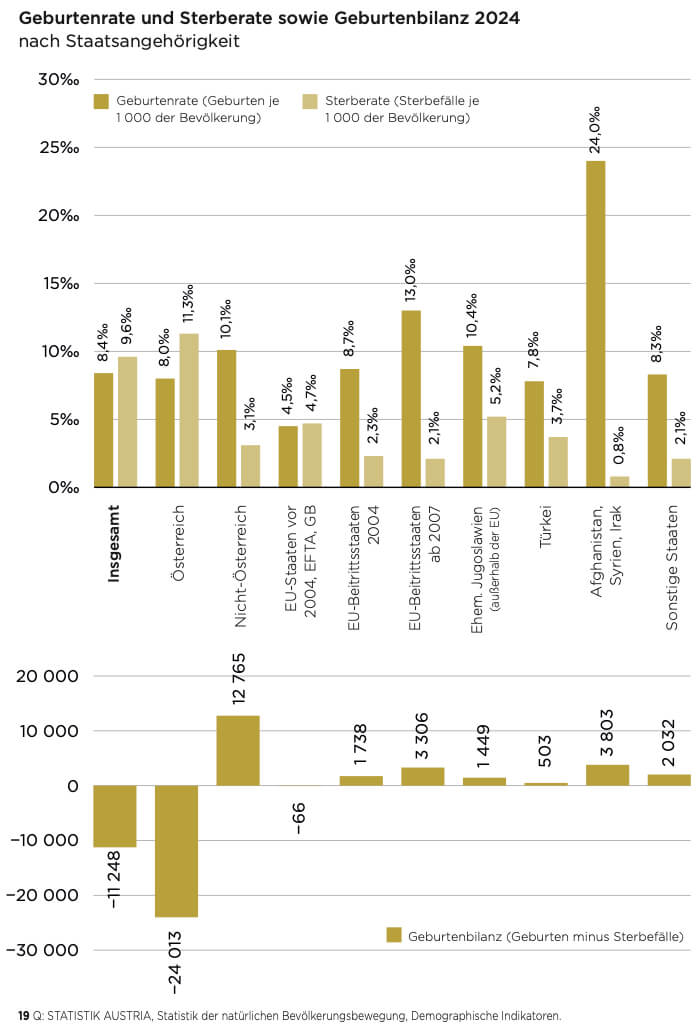
Austria’s Native Population in Decline as Numbers of Syrian, Afghan and Iraqi Migrants Rise
New demographic statistics paint a dramatic picture: while the number of Austrians fell by more than 24,000 in 2024, the number of migrants, particularly from Islamic countries, rose significantly. The highest birth rate increases were observed among Syrians, Afghans, and Iraqis. A quiet demographic shift is underway.
In 2024, Austria recorded 77,200 births and 88,500 deaths, resulting in a negative birth-death balance. However, the new situation is not affecting everyone equally: among Austrian nationals, a decrease of 24,013 people was registered. In contrast, the number of foreign nationals increased by 12,765.
A birth rate chart for 2024 clearly shows that only certain groups are growing, and all of them have a migration background. This is based on data from Statistics Austria (Statistik Austria) and the Austrian Integration Fund (OIF) in their statistical yearbook Migration and Integration.
Growth Driven by Three Groups
The greatest population increases, with by far the highest birth rates and lowest mortality rates, were seen among Syrian, Afghan, and Iraqi migrants. This means migrants are driving population growth in Austria while the proportion of the native population is shrinking.
- Syrians, Afghans, Iraqis: +3,803
- EU countries joined since 2007 (mainly Romania, Bulgaria): +3,306
- Other countries: +2,032
- Former Yugoslavia (non-EU): +1,449
- Turkiye: +503
- Western European countries (EU-14, EFTA, UK): virtually no change: –66

Austria Sees Birth Rates Declining—But Not for All Groups
The birth rate (per 1,000 people) shows that older EU member states are practically irrelevant in terms of demographic growth, falling below even the Austrian level. In contrast, the rate for Afghans, Syrians, and Iraqis is three times higher than that of the native population.
- Afghans, Syrians, Iraqis: 24.0 per cent
- Turks: 14.9 per cent
- Eastern EU member states (joined since 2007): 13.0 per cent
- Austrians: 8.0 per cent
- EU-14, EFTA, UK: only 4.5 per cent
A particularly striking figure is the average number of children per woman (total fertility rate). Afghan, Syrian, and Iraqi women give birth to more than 3 children on average; Turkish women around 2; Austrian and Western European women one on average. Even migrant women who have acquired Austrian citizenship have fewer children than foreign nationals, but still more than Austrian-born women.
One in Thirteen Newborns Has an Islamic Background
In 2024, 2,742 Syrian, 1,021 Afghan, and 965 Turkish babies were born in Austria, amounting to 6.1 per cent of all newborns. If Bosnians are included (1,031 births), many of whom, but not all, are Muslim, the share of babies with a Muslim background rises to 7.4 per cent.
There are also notable differences in maternal age at childbirth: Austrian-born mothers give birth at an average age of 31.4 years, while foreign-born mothers averaged 28.7 years. Women who give birth at younger ages tend to have more children over time.
Die neue Bevölkerungsstatistik zeigt ein dramatisches Bild: Während die Zahl der Österreicher im Jahr 2024 um mehr als 24.000 zurückging, legten vor allem Zuwanderer aus islamisch geprägten Ländern stark zu. Der größte Geburtenüberschuss kommt von Syrern… https://t.co/Cxy7r1dtnW
— exxpress (@exxpressat) July 17, 2025
One in Four People in Austria Has a Migration Background
In 2024, an average of approximately 2.509 million people with a migration background lived in Austria—27.8 per cent of the total population. This is an increase from 2023, when the rate was 27.2 per cent.
Roughly 1.9 million people belong to the so-called „first generation” of migrants—those who were born abroad and moved to Austria.
The remaining 634,000 people were born in Austria to foreign-born parents and are considered second-generation immigrants. The share of the population with a migration background has increased by a third over the past decade, from 20.4 per cent in 2014 to 27.8 per cent in 2024.
As of early 2025, there were around 1.9 million foreign nationals without Austrian citizenship living in the country, that is, 20.2 per cent of the total population. Germans remain the largest group in this category.
As of 1 January 2025, approximately 239,500 Germans lived in Austria, followed by 155,700 Romanian, 124,800 Turkish, 122,500 Serb and 112,400 Hungarian nationals.
The sixth to tenth largest groups are Croatian, Syrian, Bosnian, Ukrainian, and Polish nationals. Among Austrian provinces, the highest proportion of foreign-born residents is found in Vienna (40.9 per cent), followed by Vorarlberg (23.6 per cent), Salzburg (22 per cent), and Tyrol (21.1 per cent). The lowest figures are in Burgenland (13.7 per cent), Lower Austria (14.9 per cent), and Carinthia (15.3 per cent).
In 2024, the highest number of asylum applications in Austria came from Syrian nationals (13,909), followed by Afghans (3,396) and Turks (1,121).
In an EU-wide comparison of asylum applications submitted in 2024, Austria ranks eighth. Around 17,000 people were granted asylum in Austria that year, which is the second-highest figure since 2017. The majority were Syrians (12,500), Afghans (2,100), and Somalis (630), according to the Austrian Integration Fund’s report.
Migrationsbericht 2025: Seit 2015 ist der Anteil der Migranten an der österreichischen Bevölkerung um rund 38 Prozent gestiegen. https://t.co/CHqrlXW3WS pic.twitter.com/ThSvAZwPdQ
— Kronen Zeitung (@krone_at) July 16, 2025

